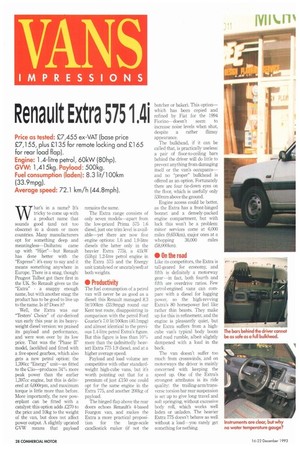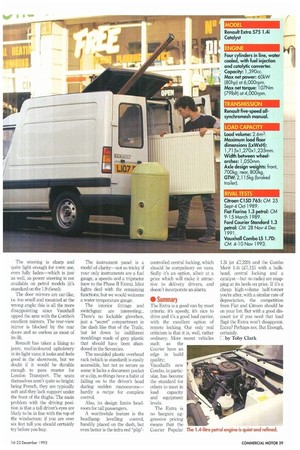VANS
Page 30

Page 31

If you've noticed an error in this article please click here to report it so we can fix it.
IMPRESSIONS
Renault Extra 575 1,41
Price as tested: £7,455 ex-VAT (base price £7,155, plus £135 for remote locking and £165 for rear load flap).
Engine: 1.4-litre petrol, 60kW (80hp). GM: 1,415kg. Payload: 500k9. Fuel consumption (laden): 8.3 lit/100km (33.9mpg).
Average speed: 72.1 km/h (44.8mph).
WThat's in a name? It's tricky to come up with a product name that sounds good (and not too obscene) in a dozen or more countries. Many manufacturers opt for something deep and meaningless—Daihatsu came up with "Hijet"—but Renault has done better with the "Express": it's easy to say and it means something anywhere in Europe. There is a snag, though: Peugeot Talbot got there first in the UK. So Renault gives us the "Extra" a snappy enough name, but with another snag: the product has to be good to live up to the name. Is it? Does it?
Well, the Extra was our "Testers' Choice" of car-derived van early this year in its heavyweight diesel version: we praised its payload and performance, and were won over by its low price. That was the "Phase II" model, facelifted and fitted with a five-speed gearbox, which also gets a new petrol option: the 1,390cc "Energy" unit—as fitted to the Clio—produces 34% more peak power than the earlier 1,397cc engine, but this is delivered at 6,000rpm, and maximum torque is little more than before. More importantly, the new powerplant can be fitted with a catalyst: this option adds £270 to the price and 10kg to the weight of the van, but does not affect power output. A slightly uprated GVW means that payload remains the same.
The Extra range consists of only seven models—apart from the low-priced Prima 575 1.6 diesel, just one trim level is available—yet there are now five engine options: 1.6 and 1.9-litre diesels (the latter only in the heavier Extra 775), a 41kVs7 (55hp) 12-litre petrol engine in the Extra 575 and the Energy unit (catalysed or uncatalysed) at both weights.
• Productivity
The fuel consumption of a petrol van will never be as good as a diesel: this Renault managed 8.3 lit/100km (33.9mpg) round our Kent test route, disappointing in comparison with the petrol Ford Courier's 7.0 lit/100km (40.1mpg) and almost identical to the previous 1.4-litre petrol Extra's figure. But this figure is less than 10% more than the (admittedly heavier) Extra 775 1.9 diesel, and at a higher average speed.
Payload and load volume are competitive with other standard weight high-cube vans, but it's worth pointing out that for a premium of just 1150 one could opt for the same engine in the Extra 775, and another 200kg of payload.
The hinged flap above the rear doors echoes Renault's 4-based Fourgon van, and makes the Extra a more practical proposition for the large-scale candlestick maker (if not the butcher or baker). This option— which has been copied and refined by Fiat for the 1994 Fiorino—doesn't seem to increase noise levels when shut, despite a rather flimsy appearance.
The bulkhead, if it can be called that, is practically useless: a pair of floor-to-ceiling bars behind the driver will do little to prevent anything from damaging itself or the van's occupants— and no "proper" bulkhead is offered as an option. Fortunately there are four tie-down eyes on the floor, which is usefully only 530mm above the ground.
Engine access could be better, as the Extra has a front-hinged bonnet and a densely-packed engine compartment, but with luck this won't be a problem: minor services come at 6,000 miles (9,650km), major ones at a whopping 36,000 miles (58,000km).
• On the road
Like its competitors, the Extra is tall-geared for economy, and fifth is definitely a motorway gear—in fact, both fourth and fifth are overdrive ratios. Few petrol-engined vans can compare with a diesel for lugging power, so the high-revving Extra's 80 horsepower feel like rather thin beasts. They make up for this in refinement, and the engine is pleasantly quiet, but the Extra suffers from a highcube van's typical body boom and road rumble, albeit slightly dampened with a load in the back.
The van doesn't suffer too much from crosswinds, and on motorways the driver is mainly concerned with keeping the speed up. One of the Extra's strongest attributes is its ride quality: the trailing-arm/transverse torsion bar rear suspension is set up to give long travel and soft springing, without excessive body roll, which works well laden or unladen. The heavier Extra 775 doesn't behave as well without a load you rarely get something for nothing. The steering is sharp and quite light enough for town use, even fully laden—which is just as well, as power steering is not available on petrol models (it's standard on the 1.9 diesel).
The door mirrors are car-like, i.e. too small and mounted at the wrong angle; this is all the more disappointing since Vauxhall upped the ante with the Combo's excellent mirrors. The rear-view mirror is blocked by the rear doors and as useless as most of its ilk.
Renault has taken a liking to jazzy, multicoloured upholstery in its light vans; it looks and feels good in the showroom, but we doubt if it would be durable enough to pass muster for London Transport. The seats themselves aren't quite so bright being French, they are typically soft and they lack support under the front of the thighs. The main problem with the driving position is that a tall driver's eyes are likely to he in line with the top of the windscreen: if you are over six feet tall you should certainly try before you buy. The instrument panel is a model of clarity—not so tricky if your only instruments are a fuel gauge, a speedo and a tripmeter (new to the Phase IT Extra). Idiot lights deal with the remaining functions, but we would welcome a water temperature gauge.
The interior fittings and switchgear are interesting... There's no lockable glovebox, just a "secret" compartment in the dash like that of the Trafic, but let down by indifferent mouldings made of grey plastic that should have been aban. doned in the Seventies.
The moulded plastic overhead rack (which is standard) is easily accessible, but not as secure as some: it lacks a document pocket or a clip, so things have a habit of falling on to the driver's head during sudden manoeuvres— hardly a recipe for complete control.
Also, its design limits headroom for tall passengers.
A worthwhile feature is the headlamp levelling control, handily placed on the dash, but even better is the infra-red "plip" controlled central locking, which should be compulsory on vans. Sadly it's an option, albeit at a price which will make it attractive to delivery drivers, and doesn't incorporate an alarm.
• Summary
The Extra is a good van by most criteria: it's speedy, it's nice to drive and it's a good load carrier, with the excellent option of remote locking. Our only real criticism is that it is, well, rather ordinary. More recent vehicles such as the Courier have an edge in build quality;
Vauxhall's new Combo, in particular, has become the standard for others to meet in load capacity and equipment levels.
The Extra is no bargain: aggressive pricing means that the Courier Popular 1.3i (at 17,220) and the Combo Merit 1.4i (17,125 with a bulkhead, central locking and a catalyst—but no radio) are snapping at its heels on price. If it's a cheap high-volume half -tonner you're after, with a similar rate of depreciation, the competition from Fiat and Citroen should be on your list. But with a good discount (or if you need that load flap) the Extra won't disappoint. Extra? Perhaps not. But Enough, certainly 17 by Toby Clark




















































































